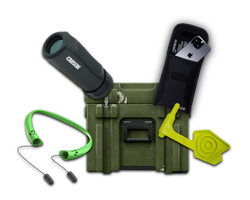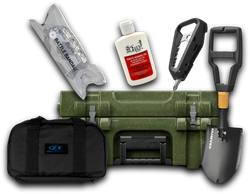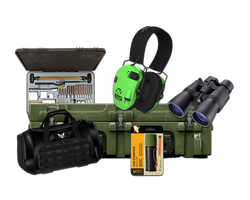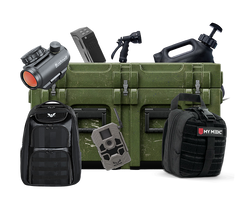How to Practice Target Shooting: Mastering Your Skills for Better Accuracy
Table of Contents
- Introduction
- Understanding the Fundamentals of Shooting
- Dry Fire Practice Techniques
- Live Fire Drills and Progressions
- Mental Conditioning for Shooters
- Utilizing Tactical Gear for Enhanced Training
- Target Shooting Games and Fun Practices
- Staying Safe and Responsible While Practicing
- Conclusion
- FAQ
Introduction
Imagine standing at the shooting range, the sun filtering through the trees, the sound of distant gunfire echoing in the air. You take a deep breath, steady your hands, and focus your gaze on the target ahead. But what if, despite your best efforts, your shots seem to veer off course? Target shooting is not just about pulling the trigger; it requires dedication, technique, and consistent practice. A surprising statistic reveals that over 70% of gun enthusiasts struggle with accuracy due to a lack of structured practice. So, how can you refine your skills and improve your aim?
In this blog post, we will delve into the essential techniques and practices for mastering target shooting, whether you are a beginner or an experienced shooter looking to hone your skills. We will explore a variety of methods, from basic stance and grip to advanced drills and mental strategies. Additionally, we will highlight how Crate Club’s curated tactical gear and subscription services can support your journey to becoming a proficient shooter.
By the end of this article, you will have a comprehensive understanding of effective target shooting practices, enabling you to enhance your performance and confidence at the range. We will cover the following key areas:
- Understanding the Fundamentals of Shooting
- Dry Fire Practice Techniques
- Live Fire Drills and Progressions
- Mental Conditioning for Shooters
- Utilizing Tactical Gear for Enhanced Training
- Target Shooting Games and Fun Practices
- Staying Safe and Responsible While Practicing
Let’s embark on this tactical journey to elevate your shooting skills to the next level.
Understanding the Fundamentals of Shooting
Before diving into specific practice techniques, it’s essential to understand the fundamental elements that contribute to effective shooting. Mastering these basics will serve as the foundation for all your future practice sessions.
Stance and Grip
Your stance and grip are crucial for achieving stability and control. Here’s a breakdown of each:
-
Stance: Position your feet shoulder-width apart with a slight bend in your knees. Lean slightly forward to maintain balance. This athletic stance allows you to absorb recoil and maintain a steady aim.
-
Grip: Hold the firearm firmly but not too tightly. Your dominant hand should grip the pistol or rifle with your fingers wrapped around the grip, while your support hand provides additional stability. Ensure that your thumbs are pointed forward along the frame of the firearm.
Sight Alignment and Sight Picture
Proper sight alignment is crucial for accuracy. When aiming, ensure that your front sight is centered in the rear sight notch and aligned with the target. The sight picture should be clear, with the target slightly blurred. Focus primarily on the front sight while keeping both eyes open if possible, as this helps maintain peripheral awareness.
Trigger Control
One of the most critical aspects of shooting is trigger control. A smooth, controlled trigger pull will minimize movement and enhance accuracy. Practice the following techniques:
-
Squeeze, Don’t Pull: Imagine you are squeezing an orange instead of pulling a trigger. This mental shift helps you apply gradual pressure without jerking the firearm.
-
Follow Through: After the shot is fired, maintain your position for a brief moment to observe where the shot landed. This practice helps reinforce good habits and improves your overall technique.
Summary: Mastering the fundamentals of stance, grip, sight alignment, and trigger control sets the stage for effective shooting. These elements require consistent practice and refinement to achieve optimal results.
Dry Fire Practice Techniques
Dry firing is one of the most effective ways to practice shooting without the need for live ammunition. It allows you to focus on technique and build muscle memory in a safe environment. Here’s how to incorporate dry fire practices into your training routine:
Creating a Safe Environment
-
Ensure Safety: Before starting dry fire practice, double-check that your firearm is unloaded and that there is no ammunition in the vicinity. This is crucial for maintaining a safe training environment.
-
Choose a Suitable Location: Find a quiet and spacious area where you can practice without distractions. A blank wall can serve as an effective target for your dry fire drills.
Basic Dry Fire Drills
-
Trigger Control Drill: Aim at a spot on the wall and practice pulling the trigger without disturbing your sight picture. Focus on smooth, controlled pressure.
-
Sight Picture Drill: Set up a target at a distance that simulates your average shooting scenario. Practice aiming and maintaining the sight picture for several seconds before pulling the trigger.
-
Draw and Aim Drill: If using a holstered firearm, practice your draw and aim technique slowly and deliberately. Focus on maintaining control and accuracy as you bring the firearm into position.
Advanced Dry Fire Techniques
-
Timed Drills: Use a shot timer app to simulate pressure while practicing. Set a specific time limit for completing your shots to add a competitive edge to your practice.
-
Movement Drills: Incorporate movement into your dry fire practice. Practice drawing and aiming while moving from side to side or stepping forward and backward, simulating real-world scenarios.
Summary: Dry fire practice is a valuable tool for building shooting skills without the cost and logistical challenges of live fire. By incorporating various drills, you can enhance your trigger control, sight picture, and overall proficiency.
Live Fire Drills and Progressions
While dry fire practice is essential, live fire drills provide the opportunity to apply what you’ve learned in a real-world setting. Here’s how to structure your live fire practice effectively:
Range Etiquette and Safety
Before starting your live fire practice, familiarize yourself with range safety rules and etiquette. Always treat every firearm as if it were loaded, keep your finger off the trigger until ready to shoot, and be aware of your surroundings.
Structured Live Fire Drills
-
Fundamental Drills: Start with basic drills such as the “three-shot drill” where you fire three shots while maintaining a consistent stance and grip. Focus on accuracy rather than speed.
-
Target Transitions: Practice transitioning between multiple targets. This drill enhances your ability to quickly acquire sight pictures on different targets, simulating real-life scenarios.
-
Distance Progression: Begin shooting at close distances and gradually increase the range as your accuracy improves. This progression builds confidence and skill.
Incorporating Tactical Gear
Utilizing high-quality tactical gear can significantly enhance your shooting practice. Crate Club offers a range of curated tactical tools and accessories that can aid in your training. From EDC (Everyday Carry) gear to advanced optics, investing in reliable equipment is crucial for optimal practice.
Summary: Live fire drills provide the necessary experience to apply your skills in real-world scenarios. A structured approach, combined with quality tactical gear, will help you progress effectively in your shooting journey.
Mental Conditioning for Shooters
Shooting is as much a mental challenge as it is a physical one. Developing mental resilience and focus can significantly impact your performance. Here are some strategies for mental conditioning:
Visualization Techniques
Visualize yourself successfully executing various shooting scenarios. This mental rehearsal can enhance your confidence and performance when it comes time to shoot. Spend a few minutes before each practice session visualizing your stance, grip, and follow-through.
Breathing Exercises
Breathing plays a crucial role in maintaining focus and reducing anxiety. Practice the following techniques:
-
Deep Breathing: Inhale deeply through your nose, hold for a moment, and exhale slowly through your mouth. Repeat this several times to center yourself before shooting.
-
Controlled Breathing: Coordinate your breathing with your shooting. For example, aim and hold your breath for a moment before squeezing the trigger.
Building Mental Resilience
-
Develop a Routine: Establish a consistent practice routine that helps you mentally prepare for each session. This routine can include warm-up exercises, visualization, and dry fire practice.
-
Stay Positive: Cultivate a positive mindset. Instead of focusing on mistakes, concentrate on the progress you’ve made and set achievable goals for each practice session.
Summary: Mental conditioning is crucial for achieving peak performance in shooting. By incorporating visualization techniques, breathing exercises, and maintaining a positive mindset, you can enhance your focus and resilience.
Utilizing Tactical Gear for Enhanced Training
Investing in quality tactical gear can greatly improve your shooting experience and effectiveness. At Crate Club, we curate a range of high-quality tactical tools and training aids that can aid in your practice. Here’s how to make the most of your gear:
Essential Tactical Gear
-
Quality Firearms: Ensure your firearm is reliable and suited for your shooting style. Consider using firearms that allow for modifications and upgrades to improve performance.
-
Optics and Sights: High-quality optics can enhance your accuracy, especially at longer ranges. Consider investing in scopes or red dot sights that suit your shooting needs.
-
Holsters and Carry Gear: A comfortable and functional holster is essential for effective draw and aim. Explore Crate Club’s selection of tactical holsters designed for quick access and secure carry.
Maintaining Your Gear
Regular maintenance of your gear is crucial for optimal performance. Follow these tips:
-
Cleaning: Regularly clean your firearm and optics to ensure they function properly. Use appropriate cleaning kits and follow manufacturer instructions.
-
Inspection: Periodically inspect your gear for signs of wear and damage. Replace any worn or damaged components to ensure safety and reliability.
Summary: Investing in quality tactical gear and maintaining it properly can elevate your shooting practice. Crate Club offers a variety of curated products that can enhance your training experience.
Target Shooting Games and Fun Practices
Incorporating games and fun practices into your training routine can enhance your skills while keeping the experience enjoyable. Here are a few engaging practices to consider:
Competitive Games
-
Texas Hold’em Shoot: Create a deck of playing cards and set up targets corresponding to card values. Shooters must hit the target to earn points based on the card’s value.
-
Balloon Pop: Hang balloons at various distances and challenge shooters to pop them with a limited number of shots. This adds an element of fun while practicing accuracy.
Skill-Building Practices
-
Speed Drills: Set a timer and challenge yourself to complete a specific number of shots on target as quickly as possible, maintaining accuracy.
-
Target Transitions: Set up multiple targets at different positions and practice transitioning between them quickly and accurately.
Summary: Fun practices and competitive games can make your training sessions more engaging while helping you develop important shooting skills.
Staying Safe and Responsible While Practicing
Safety is paramount when practicing shooting. Here are some key safety practices to ensure responsible shooting:
Range Safety Rules
-
Always Treat Firearms as Loaded: Regardless of whether you believe a firearm is unloaded, always treat it as if it is loaded.
-
Know Your Target and Beyond: Be aware of what lies beyond your target. Ensure that you have a proper backstop in place.
-
Use Eye and Ear Protection: Always wear appropriate eye and ear protection while shooting to prevent injuries.
Personal Responsibility
-
Educate Yourself: Stay informed about local laws and regulations regarding firearms and shooting practices.
-
Practice Regularly: Consistent practice helps develop familiarity and confidence with your firearm, reducing the likelihood of accidents.
Summary: Prioritizing safety and responsible practices is essential for any shooter. By following range safety rules and taking personal responsibility, you contribute to a safer shooting environment.
Conclusion
Mastering the art of target shooting requires dedication, practice, and the right mindset. By understanding the fundamentals, incorporating dry fire and live fire drills, focusing on mental conditioning, and utilizing quality tactical gear, you can significantly enhance your shooting skills. Remember, the journey to becoming a proficient shooter is ongoing, and each practice session brings you one step closer to your goals.
As you embark on this journey, consider exploring Crate Club's subscription services for curated tactical gear tailored to your needs. Whether you're a beginner or an experienced shooter, our collections are designed to support your training and preparedness.
Join Crate Club Today
-
Crate Club Subscription Services: Discover our subscription tiers, ranging from casual to professional gear, designed to help you be better prepared for any situation. Explore Crate Club Subscription Services
-
Crate Club Shop: Shop our curated collection of tactical gear and survival tools to elevate your practice. Visit Crate Club Shop
FAQ
Q: How often should I practice target shooting? A: Aim for a consistent practice schedule, ideally once or twice a week, incorporating both dry fire and live fire sessions.
Q: What is the best distance to practice shooting? A: Start at closer distances (around 7 yards) and gradually increase as your accuracy improves. Adjust distances based on your shooting goals.
Q: Can I practice shooting at home? A: Yes, dry fire practice can be done at home in a safe environment. Ensure your firearm is unloaded and follow safety protocols.
Q: What equipment should I invest in for target shooting? A: Start with a reliable firearm, quality optics, a comfortable holster, and essential safety gear like eye and ear protection.
Q: How can I improve my shooting accuracy? A: Focus on the fundamentals—stance, grip, sight alignment, and trigger control. Regular practice, both dry and live fire, is essential for improvement.
Share this article



